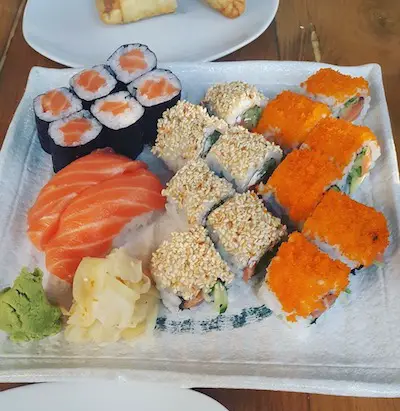We are reader supported. When you purchase through links on our site, we may earn an affiliate commission. Also, as an Amazon affiliate, we earn from qualifying purchases.
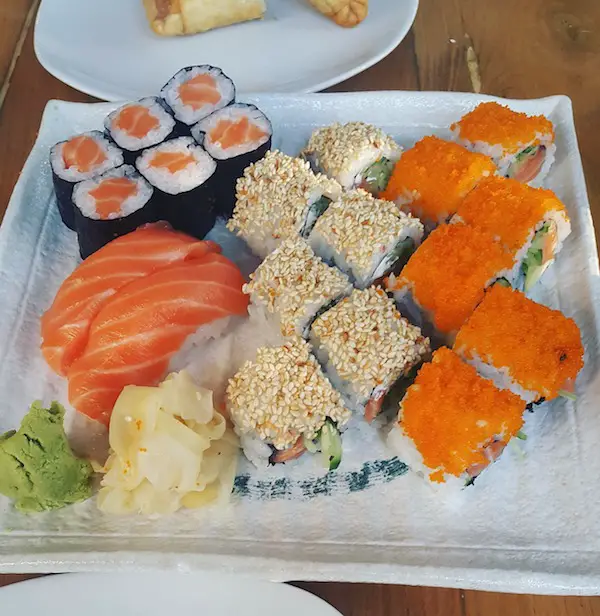
Ahh! there’s nothing like the good old traditional maki rolls, but I am sure you will agree that we don’t mind indulging our tastebuds in the sea of flavors presented in westernized rolls. Although the inside-out California roll is not really a Japanese thing, food lovers just can’t have enough of the sushi toppings on the bed of rice.
However, let me correct here by saying that toppings are not just limited to sushi rolls but the fish part used in nigiri has also highly evolved in recent times. Unlike the past when you had a few options for neta (fish) over the bed of rice, the modern chefs of today don’t mind experimenting with creative toppings to present exciting new flavors.
The sushi toppings serve a dual purpose – first, they enhance the flavor and make your sushi dish taste more exciting. Secondly, they add value to the sushi aesthetics by making your roll or nigiri look more appealing and colorful.
If you are a home chef who loves to cook sushi for the family, why stick to the same old drill? Delight your loved ones with various new sushi toppings that add more zing, sweetness, or crispiness to your sushi. Enough of talking, now let’s dive into the list of sushi topping ideas!
Sushi Topping Ideas (Raw/ Cooked Meat)
#1. Tuna (Maguro)
This is perhaps the most popular raw fish used in sushi and it works as a perfect reddish-purple topping. Also known as akami, this is the thin slice you get from bluefin tuna which can grow up to 3 meters in length. As the fish matures, the flavor and texture of the meat also vary. Akami is the lean cut with a meaty flavor and it may be pickled in soy sauce or powdered with condiments.
#2. Chu-toro
This is also tuna meat but it varies a lot in terms of flavors and texture. It is taken from the middle belly portion of tuna and the high-fat content makes it a highly prized sushi topping.
#3. O-toro
If you want the toppings to melt into your mouth with its soft texture and extremely buttery texture then choose o-toro. This is the flesh cut from the front of the belly part and the high-fat content can be seen in the marbled appearance. It may be used as a raw topping or treated with a blowtorch to make it smoky.
#4. Salmon
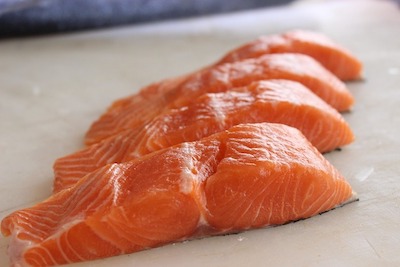
The orange flesh with white stripes is perhaps what comes to your mind when talking about sushi because it’s one of the most popular toppings used. Although it was not a traditional sushi topping, today a sushi platter is incomplete without it. The mild flavor, medium-softness of raw salmon makes it a preferred choice.
#5. Toro salmon
If you would like your salmon topping to melt like butter in your mouth then I would recommend that you use the toro cut from the fat-rich belly section. This rich and fatty cut of salmon may be served raw or lightly grilled to enhance the texture.
#6. Shime-saba
Often referred to as marinated mackerel, the saba is a popular fish topping in Japan because it is easily available. Besides being cheap, it also has high amounts of omega3 fatty acid. As the flesh of saba tends to rot quickly, it is often pickled with salt and vinegar.
#7. Aji
This fish topping often surprises first-timers with its mildly sweet flavor. Also known as horse mackerel, it has an attractive pink color and high content of omega 3. Thinly sliced raw meat is typically used as toppings or the meat may be marinated with vinegar and salt. It is often paired with lemon juice to add to the flavor.
#8. Iwashi
Although the canned iwashi or sardines have a pungent and fishy flavor, the fresh raw meat has a surprisingly sweet and buttery taste. This shiny silver color fish is abundantly available, hence considered low-grade but nevertheless, they are one of the extremely delicious sushi toppings. It may be paired with ginger and negi to balance the fatty content.
#9. Sawara
Also known as Spanish mackerel, this is often known as the highest quality of mackerel found in Japan. The meat is opaque and white, while the flavor is slightly meaty. It may be served as a plain sushi topping or grilled with a little salt to make it succulent.
#10. Sanma
Also known as Pacific saury, this fish species is an autumn specialty. It may be used as a raw sushi topping or cooked to make it more succulent. It may be further topped with finely chopped spring onions or ginger
#11. Kampachi
In English, we call it yellowtail, but the Japanese have different names for the fish reaching different maturity levels. When it reaches a mid-maturity age, it is called kampachi. The fish is available from early summer to the autumn season. The flesh is cream colored with a pink edge, and the raw flesh has a mildly sweet flavor.
#12. Buri
Yellowtail again but this time refers to the adult or a fully mature version of the fish. Both buri and kampachi are high highly prized cuts of the fish. Buri has a creamy flavor and may have a whitish or pinkish hue depending on the fat content which increases as winter approaches.
#13. Engawa
Known as flatfish fin in English, the Engawa is taken from the tail fin area of a flounder. The meat is white and thin, while the texture is slightly chewy. I especially love the buttery flavor which makes it an amazing sushi topping. Engawa may be served raw or cured with ponzu sauce and a pinch of salt.
#14. Katsuo
This is the Japanese term for bonito, one of the oldest traditional sushi toppings used since the Edo era. The meat of this fish has a red-purple color and meaty texture. The flavor is typically milder in spring but it turns richer and fattier in colder months. It may be topped with ginger to balance the oiliness.
#15. Tai or sea bream
The fish is easily distinguished by its pinkish-white flesh, translucent texture, and sweet taste. It is known to be low in fat and high in vitamin, thus highly preferred by diet-conscious sushi eaters.
#16. Kohada
This is the Japanese name for gizzard shad and it is one of dazzling silverfish similar to sanma, iwashi, and aji. It is one of the popular nigiri sushi toppings and the fillets may be simply layered or woven more decoratively. It may be served raw or cured with salt and vinegar.
#17. Octopus or Taco

In its raw form, octopus meat is bland, hence it is usually blanched before using as a sushi topping. After blanching, it has a chewy texture and mildly sweet flavor. The leg part is thinly sliced lengthwise and the topping is fastened to the bed of sushi rice with a nori belt.
#18. Ika or squid
In Japan, you will find a variety of squids and one of the most popular is called the surume ika. It is usually sliced lengthwise and arranged crossways over the sushi rice. It is often paired with shiso leaf to balance out the soft and sweet flavor of the squid.
#19. Geso or yari ika
This refers to the finely sliced legs of a cuttlefish, called yari ika in Japanese. They may be served raw, grilled or blowtorched to enhance the flavor. The thin slice of meat is dressed in ponzu sauce or citrus juice and then arranged over sushi rice.
#20. Hotate or scallops
The glossy, smooth, and sweet scallops are to die for and they are one of the most delicious sushi toppings on earth. To use scallops as nigiri topping, the round soft flesh is sliced to give it a butterfly shape and then pressed on a bed of rice. It goes well with some citrus juice.
#21. Unagi or freshwater eel
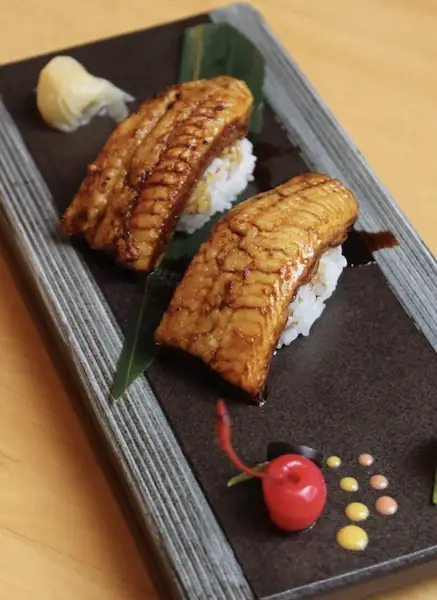
This is another bold and rich seafood that requires an acquired taste. Eel is usually grilled and smeared with soy-based eel sauce to enhance the flavor. Some citrus juice may be squeezed over it to balance the richness.
#22. Anago or saltwater eel
This is the saltwater counterpart of unagi. It has a bright taste and soft flavor which sets it apart from its cousin. The texture is rather fluffy and the grilled fillets are basted with eel sauce before adding as toppings over nigiri or sushi roll.
#23. Ebi or prawns

They are one of the most scrumptious looking sushi toppings that come in different forms. The large and fleshy prawns known as kuruma-ebi are the most popular ones, followed by sweet and small ama-ebi, and then comes the plump botan-ebi. The outer skin is peeled and the tail is left for decorative purpose.
#24. Uni or sea urchin
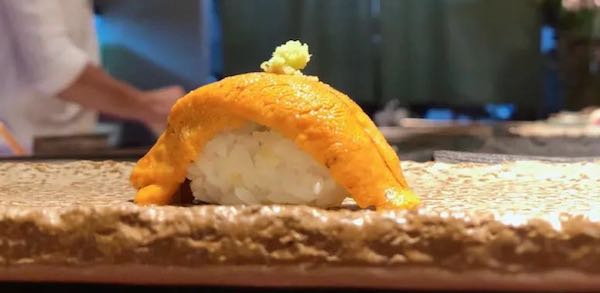
The oceanic flavor and buttery texture set uni apart from all other sushi toppings. While some people may find it gross at first glance, the orange colored uni is one of the highly sought after delicacies in Japan. It requires an acquired taste and once you are able to appreciate it, there’s no looking back. It has a tongue-like shape and pairs up with a dash of wasabi when used as toppings.
#25. Kazunoko
These are fish eggs known as herring roe in Japanese and they are typically sundried or pickled in salt. They have a sharp flavor and crunchy taste to match. It may be fastened to a bed of rice using a nori strip.
#26. Hokkigai or surf clam
This pretty seafood has an attractive appearance in the shape of a fin. It may be peach to bright pink colored. The flavor is mild, which makes it one of the most prized toppings for nigiri sushi.
#27. Tamagoyaki
This is the sweet and delicious Japanese rolled omelet that requires a lot of skills to prepare. It is often served as dessert after a sushi meal. Many chefs use this as a tasty sushi topping over nigiri and it is fastened to rice with a nori strip. I have created an article on tamagoyaki where you can find the recipe and other details.
#28. Tobiko (Flying fish roe)
Tobiko are eggs of tropical flying fish and it is known for its colourful appearance and crunchy texture. If you regularly dine at sushi restaurants, you may have seen the bright-red round balls used as toppings over inside-out rolls. It has a mild sweet and salty taste.
#29. Masago (Capelin roe)

Masago (see detailed reviews) refers to the eggs derived from a certain species of Atlantic and Artic fish. Unlike tobiko, masago has a dull appearance, as a result, they are usually dyed in restaurants to give them a pleasing appearance. While it tastes almost similar to tobiko, it lacks the crunchy texture. Many restaurants use magaso in the place of tobiko because they are relatively cheaper.
#30. Wagyu beef
This is a non-traditional sushi topping but still quite popular for the high-fat content that gives it a rich, sweet, and savory taste. The beef is seasoned and grilled to make the meat even more succulent.
Vegan Sushi Topping Ideas
#30. Avocado
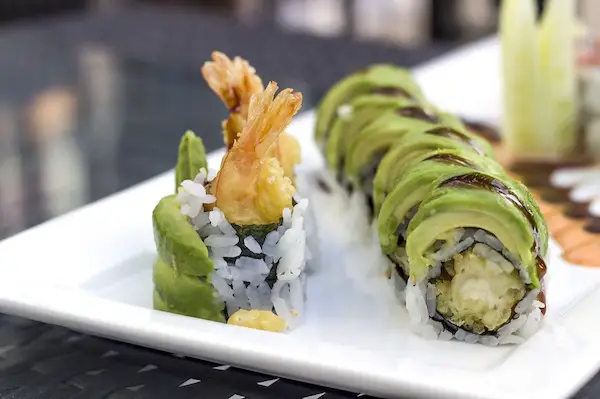
This is one of the most popular vegetable topping used in sushi and you will find its use in almost every other uramaki recipe such as caterpillar rolls, dragon roll and so on. To prepare the topping, a ripe but firm avocado is de-skinned and cuts into thin slices that shape well over the sushi rolls. It has a soft texture and sweet taste.
#31.Bell Peppers
The orange bell peppers can be prepared in a way to resemble the salmon. The silky smooth skin and crunchy texture make it a great veggie option to use as toppings on nigiri or sushi roll. Some chefs prefer marinating the bell pepper slices with rice vinegar and mirin to soften the texture.
#32. Nasu or eggplant
This is yet another delicious vegetarian topping that is grilled or pickled before use. The grilled nasu has a soft and buttery texture while pickled one has a tangy taste and chewy texture. You may also prepare eggplant tempura and use it as a topping for nigiri or uramaki rolls.
#33. Shitake mushrooms
Despite its strong and bold flavor, it is one of the most delicious toppings, slightly flavored with soy sauce and salt. It may also be lightly grilled to enhance the flavor. Succulent and delicious shiitake mushrooms are one of my favorite vegan sushi toppings I can have anyway!
#33. Strawberry
If you ever attempt to make a vegan rainbow roll, consider finely cut strawberry slices as your sushi toppings. It not only adds sweetness to the dish but the juicy texture also makes the food more enjoyable.
#34. Mango
When it’s the season of ripe and juicy mangoes, you must be irking to use it in your favorite dish. So, why not try mango toppings on your nigiri sushi to add a different angle to this delicious cuisine. Take a ripe but firm mango, and cut the flesh into thin slices to decorate as toppings.
#35. Sesame seeds
Both black and white sesame seeds can be used for garnishing as a crunchy topping for California style sushi rolls. I recommend toasting the sesame seeds slightly to enhance the aroma before sprinkling over the sushi rice.
#36. Imitation Crab sticks

You may use surimi or imitation crab sticks as topping on your nigiri sushi. Cut out a thin nori strip to fasten the surimi to the bed of seasoned sushi rice, and enjoy the delight. Shredded pieces of surimi may also be mixed with mayo or sriracha sauce and used as toppings on Gunkanmaki.
#37. Apple and Pear
These may appear to be non-traditional but nevertheless, there are chefs who like experimenting with different types of sushi toppings. Cut an apple or pear, remove seeds and make thin slices that can be placed over nigiri and secured with rice using a nori strip. You may season the fruits with pepper and salt to enhance the taste.
#38. Sweet Potato
If you are a vegan, this is a delicious topping you can use in your nigiri or uramaki roll. Grill or roast a sweet potato and make thin slices to be used as tasty toppings. You may also use sweet potato tempuras to add crunchiness to the dish.
If you have more exciting sushi topping ideas then please let me know in the comments below and I will add it here. I have also created an article that talks about 30 good ideas for sushi roll fillings, check it out!

